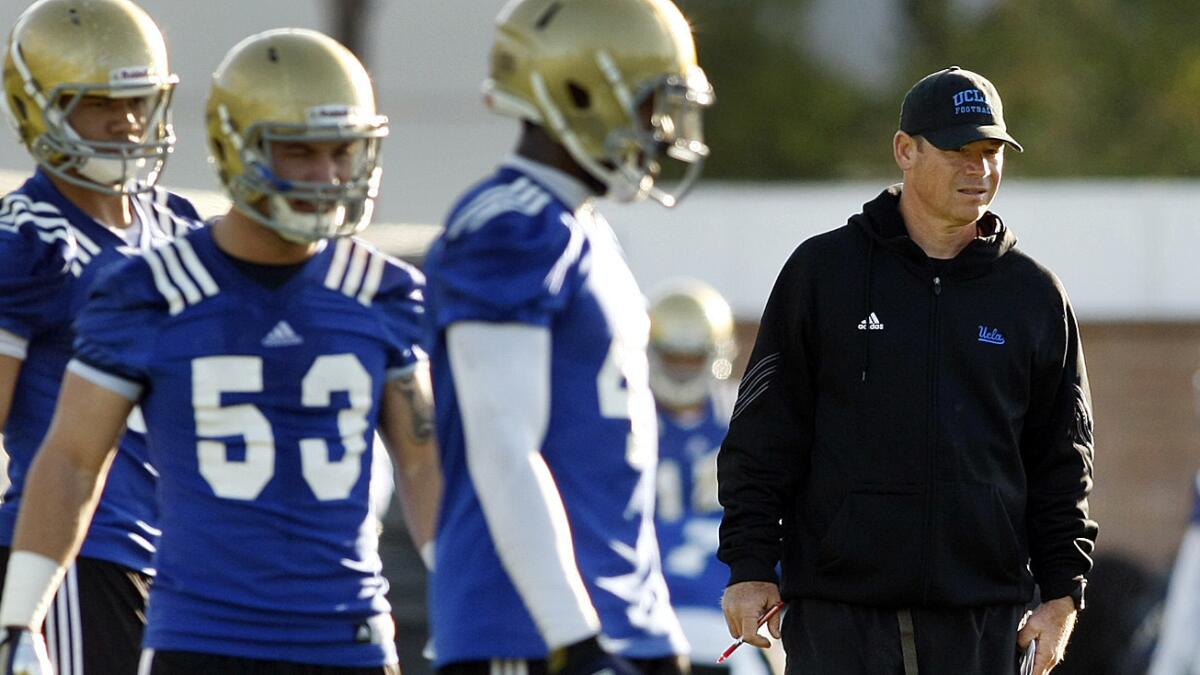UCLA football program is casting wider net in recruiting efforts

- Share via
UCLA appears to have found a winning football recruiting strategy, one that has allowed the Bruins to climb in the Pac-12 Conference standings and the national rankings in the last couple of years.
Coach Jim Mora and his staff are working hard to control their home region first, and their state second. But when there is a special need to address, or special player they want, they are not afraid to stretch out nationally and fight more established college football powers on rival turf.
It’s an approach that has worked here before — across town at USC when the Trojans’ efforts were fueled by former coach Pete Carroll and his recruiting coordinator, Ed Orgeron.
UCLA’s work is led by Mora, associate head coach Adrian Klemm and recruiting coordinator Angus McClure.
Two of the Bruins’ best players, quarterback Brett Hundley — who was already at UCLA when Mora was hired — and linebacker/running back Myles Jack came to Westwood from out of state, Arizona and Washington, respectively. And when the Bruins needed offensive linemen, Klemm drew Simon Goines and Caleb Benenoch out of Texas.
UCLA also has achieved some success in Florida, attracting backup quarterback Asiantii Woulard from Palm Bay, defensive back Fabian Moreau from Sunrise, and Sean Covington, a prized kicking prospect, from Treasure Island.
The Bruins also caused a stir when T.J. Simmons, a highly regarded running back from Lakeland, Fla., recently gave them a verbal commitment.
Simmons’ commitment is non-binding — he still has his senior season at Lakeland Christian High left to play — but his choice is yet another reminder of UCLA’s growing national pull. Simmons has good size at 6 feet, 195 pounds, and explosive speed. He is a sprinter who plans to also compete for the Bruins’ track and field team.
Mora and other UCLA coaches are prohibited by NCAA rules from talking about Simmons until he signs a national letter of intent, but the Bruins coach confirmed UCLA’s recruiting emphasis: “Our primary focus is California and Southern California specifically, but like every school we will supplement by going national.”
In 2010, UCLA had 21 players from outside California on its football roster. This summer, it has 35.
As Carroll did at USC, Mora managed to create some momentum by winning immediately and is now trying to build on it.
Carroll was 6-6 in 2001, his first season at USC, but then went 82-9 over the next seven seasons. UCLA was 4-8 and 6-8 in the two seasons before Mora took over. Mora’s first team went 9-5, and the Bruins were 10-3 last season.
For Simmons, UCLA was recruiting against dozens of strong programs, including Ohio State, Notre Dame, and perennial top-25 programs from the Southeast such as Florida, Auburn and Miami.
That was no average recruiting effort, said Mike Farrell, an analyst for Rivals.com.
“If you go in there after a T.J. Simmons, you’re beating your chest and you’re saying, ‘I don’t care. We’re going to try to get this kid,’” Farrell said. “And that’s what makes these UCLA recruiters so good.”
Farrell said Southeastern Conference and Atlantic Coast Conference teams go to great lengths to defend their turf, which is a hotbed for football talent. He also said there are some risks for a program that chases talent far and wide. One issue is that it might upset high school coaches back home if they feel good local talent is being passed over.
But taking that chance is worth it for a team trying to reach national prominence. Farrell noted that Florida State won last season’s national title with a roster heavily stocked with players from the Southeast.
“It’s one of those things where schools say, ‘We’ve got to try. California’s great, we’re going to recruit California kids first and foremost and West Coast kids, but we’ve got to try to get some of these Southeast kids on our roster because they can be absolutely difference-makers,’” Farrell said.
Mora cited UCLA’s academic reputation and the team’s family atmosphere as draws for recruits when the Bruins go national. He said the campus’ location also helps his pitch.
“We’re in Westwood, one of the most beautiful parts of the country, and they come to this campus and it’s very different than what they would expect,” Mora said. “It doesn’t sit downtown. It sits pressed up against the mountains, five miles from the beach. The topography is beautiful. It’s hilly. It’s green. It’s healthy. It’s safe. It’s an amazing campus.”
Simmons said he felt a connection to UCLA because he quickly saw how he could fit in.
“I mainly felt at home as soon as I got on campus and really wasn’t [thinking] a lot [about] how am I going to be able to act while I’m out here,” Simmons said in a phone interview. “They just welcomed me as family.”
A big part of fitting into a football family at any school is building rapport with coaches. For Simmons, UCLA hit all the right buttons and being far from home wasn’t an issue. He had a different priority.
“Having a personal connection with the coach really has to mean a lot in your recruitment,” Simmons said, “because you’re going to be with that coach for about four years of your college career, so you want to have a good relationship with him.”
More to Read
Go beyond the scoreboard
Get the latest on L.A.'s teams in the daily Sports Report newsletter.
You may occasionally receive promotional content from the Los Angeles Times.






